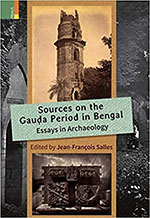Gauda as a political entity remains an elusive concept in the early history of Bengal. Although it is considered to have emerged in about the middle of the sixth century CE in the present-day northern Bengal (incorporating parts of modern West Bengal and Bangladesh), there is no textual evidence verifying this. Hence its genesis and rise in the regional power trajectories of early Bengal continue to be obscure. This edited volume constituted of ten chapters and the Introduction aims to address this problem of locating Gauda in archaeological sources. It grew out of the proceedings of a seminar at Chandernagore, West Bengal, organized by the Institut de Chandernagore, the Indian Museum, Kolkata and the Franco-Bangladeshi Archaeological Mission in February 2013.
The chapters could have been divided into three sections instead of the existing sequential arrangement. The principle of this ordering is not clear. The chapters by Suchandra Ghosh, Vincent Lefèvre, Sylvain Brocquet and Jean-François Salles raise provocative inquiries on the idea of Gauda which could have formed the first section. Suchandra Ghosh aims to understand the political geography of Gauda through textual and inscriptional sources, exploring its idea as a diffused entity with no distinctively delimited territorial notion. The cultural connotations of the term Gauda were visible in the writing tradition of the Gaudi script and the engagement of many Gauda scribes in royal courts of other dynastic powers. Vincent Lefèvre makes an excellent contribution in delineating a methodology for identifying a ‘school of sculpture’ through an art historical lens.

